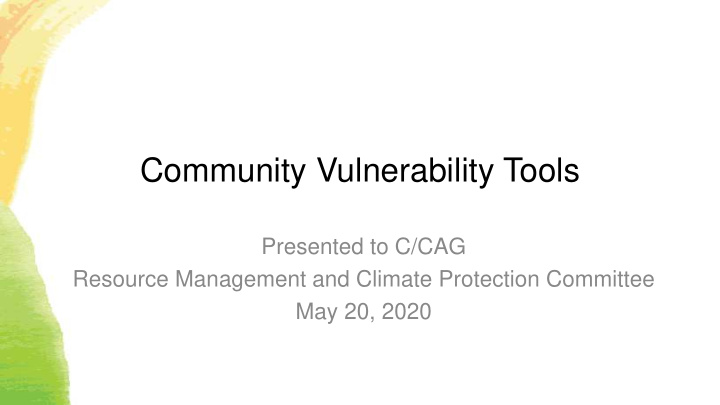



Community Vulnerability Tools Presented to C/CAG Resource Management and Climate Protection Committee May 20, 2020
Outline • Why use Community Vulnerability Tools? • Major tools • Benefits and examples of how to use them • Discussion Goal • Get your feedback on other resources • Provide access to the tools to PCE, BAWSCA
Historical Context • History of Exclusionary Practices – Lending - Redlining – Real Estate – Racial Steering in 1960s – Patterns continue today • Gaps to Overcome – Health, income, discrimination – Lack of access to transit – Language, social isolation
Equity in Climate Protection Equity strategy: Provide access to climate programs by removing barriers to behavior change for all – Incentives/grants to support “sustainable” purchases: healthy food, low-carbon products – Access to “clean” infrastructure: energy, transportation
Leveraging Community Vulnerability Tools Design Programs Develop Policy Compete for Funding Direct Agency Funding
Two Ways to Target Individual / Household Geography
Individual/Household • Income verification is cumbersome – Creates barriers to those you’re trying to help – Taps into privacy fears because of immigration status • Rely on designations from other programs – PG&E: CARE program – Public schools: Free and reduced-price lunches – CA Dept. of Social Services: CalFresh
Geography Block Census Tract Block Group
California Environmental Screening Tool (CalEnviroScreen 3.0) • Statewide, by census tract • 19 measures of poverty and pollution - indexed • “Disadvantaged communities” (DACs) score 75%+ • Only 4 DACs in San Mateo County • Version 4.0 coming this year Link to tool
Low participation California Energy Commission levels for PG&E investments in Energy Equity Indicators energy efficiency Interactive Story Map • By census tract • Outcome of SB 350 Low-Income Barriers Study Low participation levels for PG&E SGIP • Clean Energy Indicators: investments for businesses & homes – Access – Investment – Resilience • A few indicators relevant to SMC Link to story map
Department of Water Resources Disadvantaged Communities (DAC) Mapping Tool • Used for water funding decisions • Input from EJCW • Uses Area Median Income Link to the tool
SMC Community Vulnerability Index (CVI) – Initiative of the County Manager’s Office – Mapped at census tract level – Current iteration: Years 2010-2016 – 7 indicators of vulnerability • No Health Insurance Coverage • Education – High School or Higher • Supplemental Security Income • Gross Rent as a Percentage of Income – Households Spending 35% or More • Poverty • Unemployment • Disability https://cmo.smcgov.org/cvi
Getting a Clearer Picture of Need CalEnviroScreen CVI Index
EXAMPLE: Using CVI to Help Underserved Businesses • Diversity Goal: Increase program participation in socially vulnerable communities and increase diversity of business owners served. • Criteria: • CVI of 41 or above OR • Minority or Female-owned business
San Francisco Bay Restoration Authority (SFBRA) • Bay Area only • Designed to allocate Measure AA funds for wetlands restoration / adaptation • Shows area median income at block group level Measure AA Interactive Area Median Income Map
ABAG Community Vulnerability Indicators • Bay Area only • Includes 10 indicators at block group level • Focus on vulnerability that reduces resilience Link to ABAG map
Climate Ready SMC Viewer – Currently in beta version – Climate risk for 2030 and 2070 • Heat • Wildfire • Precipitation & Sea Level Rise – Sources: • CVI (census tract) • ABAG (block group) – Some layers: • Housing burden • Heat and cooling degree days • Disability • Older adults • Language other than English • Non-white
EXAMPLE: Using SMC Viewer to Identify Where Cooling Centers May Be Needed by 2030 • Colored squares show projected average temperatures in 2030 • Red = avg of 75-85 degrees F • Shaded areas show socioeconomic vulnerability
EXAMPLE: Projecting Need for A/C in 2030, Overlaid with Households That May Not Be Able to Afford it • Color squares show the number of projected cooling degree days in 2030. • Red and orange squares represent hotspots. • Purple areas show housing burden
More Tools: OPR: Defining Vulnerable Communities in the Context of Climate Adaptation
More Tools: APEN: Mapping Resilience Report
Additional Resources Youth Need Index SMC All Together Better Portal • Reflects combination of factors • Sponsored by Public Health, that impact youth success Policy, and Planning • Higher scores indicate higher • Contains SMC data on: need – Health outcomes • Data include: – Health behaviors – Health care access – Juvenile Probation and Behavioral – Socioeconomic conditions Health hot spots – Child maltreatment http://www.smcalltogetherbetter.org/ – Low birthweight – Student reading proficiency, suspensions and poverty http://www.gethealthysmc.org/youth-need-data
Discussion • What’s the best approach for selecting recipients of RMCP-related programs/incentives? – Access to charging stations – Affordable EVs – Access to energy efficiency resources, solar, battery – Access to water conservation • What tools/measures will help us reach people who face barriers? What approaches will actually help them? • How do you blend local knowledge with data tools? Follow up: Would you like a demonstration of any of the tools?
THANK YOU! Kim Springer, kspringer@smcgov.org Susan Wright, swright@smcgov.org Hannah Doress, hdoress@smcgov.org
Recommend
More recommend